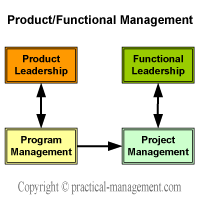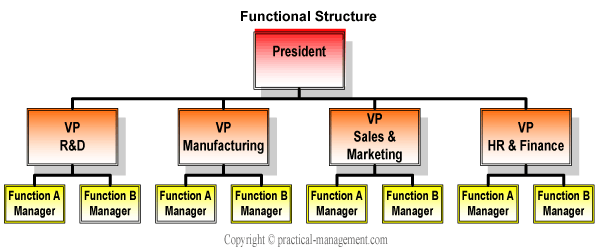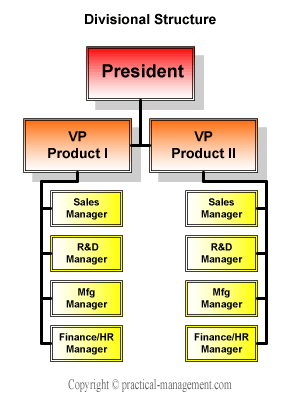Discusses the differences, strengths and weakness of two hierarchical structures of an organization.
Functional Vs Divisional Structure
Product vs. Functional Management
It is important to comprehend the role and difference of a functional leadership and product leadership, the role of project and program management within the framework of organization structure.
Product Leadership: A product has several components, the inner components that craft the product, the external components like sales, marketing, inventory, procurement, customer service etc. The product leadership defines the features and functionalities of the product, the roadmap and timelines of the product delivery & its deployment. Product leadership needs to be very well connected to their customers, since customers directly influence the requirements for the product.
Functional Leadership: Functional leaders are specialists that have high technical knowledge of their area; they are the architects who design their functional component of the product. They use their technical competency and experience to solve non-trivial problem, they are responsible for coaching and mentoring the younger staff in the organization. Functional leaders take the product vision and requirements from the product leaders, perform feasibility study and take the responsibility of mobilizing their technical core teams.
Program Management: The functional design is divided into smaller projects; each project produces a deliverable that is integrated into the final product. The program management is analogous to product management, it need to track the progress of each functional unit, manage any risk that might arise due to functional interdependencies and manage customer communications.
Project Management: It is the most atomic level of management; it involves managing resources, setting project goals, changing scope, setting deadlines, tracking project progress and raising risks when they occur. Project management is a process that is rooted in all management and leadership functions to the extent that it is inevitable.

Both product and functional leadership is related through program and project management. The management aspect can either be integral part of both product & functional or can be a separate entity. The functional leader might also be managing the projects under his team or there can be a designated project manager to do so. When there is a separate project manager position, the role for functional leader is limited to technically leading the subordinates and is disjointed from management functions. Similar is true for product manager, hence in the product/functional management illustration, all the components and their interactions are shown separately.
Functional Structure
In a functional structure, teams or groups are created based on common functions in a bottom-up manner. The result is a set of functional units such as engineering, marketing, finance, human resource etc. that are controlled and coordinated from the top level management. Functional structure are the most common type of structural design and have evolved from the concept of high specialization, high control framework of manufacturing organizations tuned towards high efficiency. Functional management is more technical oriented and less product or business oriented, while they are skilled in taking decisions in their functional areas, they are weak in the areas of product business plans, market study and product release management. If the organization does have multiple product lines, then the functional hierarchy at lowest level does get divided along product lines, thereby creating deeper hierarchies.

Strengths of functional structure
Functional structures are typically highly hierarchical; hence they inherit the properties of hierarchical structure.
- Maximizes Functional Performance: All the human knowledge, skills & infrastructure required for a particular functional activity are consolidated in a single sub-organization, this facilitates sharing of valuable expertise by superiors with their subordinates. The functional units are managed by leaders who have in-depth knowledge and experience; they are able to control the unit very effectively. Hence it harvests the potential of the unit without duplication of scarce resources, maximizing their utilization.
- Cultivates Specialists: This type of structure promotes career development of individuals aspiring to be technical specialists of their field in large organizations. If the organization has properly crafted performance management that promotes the visibility of individual skills, functional structure makes it easier to coach other and climb the hierarchical ladder.
Weakness of functional structure
- Restrictive Organizational View: Each functional unit has expertise in its own field, but lacks broader awareness about the organizations objectives or even the products. The responsibility of successfully integrating the organization lies with few top level executives, at the same time, the organizational structure limits the capabilities of the functional managers to occupy top management positions. Thus, even though such organizations might be effective initially, being controlled by few founding members, its long term efficiency is doubtful.
- Slow Response: Functional units cannot respond to fast changes in customer demands or the product since only the top level management has broad knowledge and the decision making authority. The management also performs the role of coordinating tasks across functional units, thus unless a complete plan of action is not formulated by the managements, little progress can be made in individual functional units.
- Poor Accountability: Due to weak link between product and functional units, it is hard to correlate profits of individual products to the budget and spending of individual units. The units that offer support to other functional units, like human resource or IT department, do not contribute directly to the revenue, yet they are essential components that helps in running the organization smoothly.
Most effective
- Small/medium size or few products: Functional units are effective when the organization has only few products or is small in size; the drawback of limited view of the entire organization gets negligible. One way to test it is to try to restructure the organization from a hierarchical to horizontal, if the resulting structure is not too different, it implies that organization is inherently lacking a horizontal dimension.
- Stable External Environment: Functional units are effective when the organization has routine technologies and there is less probability of emergence of competitive technology that is radically different.
Product Divisional Structure
In a divisional structure, the teams are organized in set of divisions, where each division corresponds to the end product or services provided by the organization. Each division has its own set of functional units like research, manufacturing, marketing etc and is completely self-contained. A divisional structure is less hierarchical than functional; it is formed by decomposing the functional structure along the product lines. Unlike functional management, the divisional management is more skilled along product business and lesser in core technical competencies.
Strengths of divisional structure
- Clear Accountability: Structuring along the product lines provides clear correlation between the expense and profit of the individual divisions. The business objectives of the division can be formulated more objectively and the expectations can be better agreed.
- Departmental Coordination: An objective accountability leads to better cohesion within the boundaries of the department; it creates a win-win situation where teams have mutual benefit in collaborating with each other.
- Broader skills development: Active collaborations between different specializations provide employees with opportunities for learning new skills beyond their own area of expertise. It is easier to comprehend the dynamics of a product and therefore is best suited for nurturing general managers in an organization.
- Unstable Environment: Since each division is product based and self-reliant, it can respond much quickly to changes in the external environment.
Weakness of divisional structure
- Resource Duplication: In order to make each division independent, some of the resources which could have been shared are rather duplicated. Specialists with particular domain knowledge cannot be shared across divisional boundaries.
- Inhibits career growth of Specialists: While divisional structures are good for nurturing top level managers, they are bad for technical specialists. Technical people feel alienated from their peers in other divisions and have poor exposure to the developments across the organizations.
- Divisional Affiliations: The employees feel more affiliated towards their own department and would still lack the sense of being part of a larger organization, they might know their own purpose but might not understand how they might related to organization’s objectives.
- Difficult Product Integration: When an organization produces multiple products which might be used together or are part of a larger product, the integration task becomes challenging since there is little coordination between the divisions. The product management task across different division requires regular sync-ups but the structure inherently provides little motivation for the product managers to seek this larger goal. Each divisional manager is more concerned about delivering his product and would view the integration as not part of his job or the problem.
Most Effective Conditions
- Very Large Corporations: The divisional structure is most effective for large corporations that have indeed multiple products that are poorly interrelated.
- Competitive Environment: The ability to respond rapidly to the external changes makes divisional structure best suited for highly competitive external environment.
